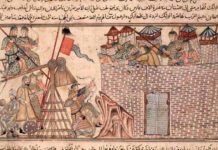Kublai Khan famously said that meat was suitable for men and vegetables for animals. Yet he himself enjoyed vegetable crepes. What else did the Mongols eat?
The Mongols are known in history for their animals, for their skill at hunting and for their toughness, as well as their ruthless and relentless persecution of settled farmers, especially those growing vegetables and fruit. As Kublai Khan said, ‘Meat is for men, grass (i.e. vegetables) is for animals.’
Anyone who today finds an authentic Mongolian restaurant will realize that this insistence upon meat remains to the modern day. Yet was meat barbecued on an improvised grill – especially the ubiquitous marmot, a creature rumored to have spread more disease than any other in known history –was this the only thing the Mongols enjoyed?
The answer appears to be no. Although the diet of the time of Genghis appears to have been rather crude and probably quite unpleasant, it does appear that the Mongols gratefully integrated into their cuisine the refinements of those peoples that they conquered. The ability of the Mongols to transmit information across the enormous width of their empire meant that their stock of cooking knowledge also rapidly developed. Kublai Khan, for example, in addition to his love of meat, also appears to have enjoyed crepes filled with julienned vegetables and doused in a creamy, saffron sauce.
This may possibly have been connected to his conversion to Buddhism. However, most Mongols preferred to remain with different ways of cooking what was most available to them: meat. One characteristic dish that remains possible is a noodle soup flavored with local herbs such as fenugreek and cumin and given substance by chunks of lamb meat or, in Tibet, yak meat (it tastes similar to beef or buffalo, apparently).
There are also many different ways in which meat can be prepared for the grill or the barbecue, including a rather pungent variation involving a great deal of Chinese mustard which would appear to go well with some strong drink such as ice-cold vodka or the fermented mare’s milk drinks that used to be the most popular among the Mongol people.
Chinese influences were the most pervasive and there is a lot of use of five spice powder and wok-fried dishes, in addition to the more popular soups and broths. However, it is also possible to discern influences from the Muslim world, from northern India and from Turkey and Eastern Europe. Perhaps the only form of protein which is very little used is the fish, which the Mongols largely considered to be a low form of incarnation and scarcely worth worrying about, apart from in the coastal regions of China.
Reference
- Cramer, Marc, Imperial Mongol Cooking: Recipes from the Kingdoms of Genghis Khan (New York: Hippocrene Books, 2001).








